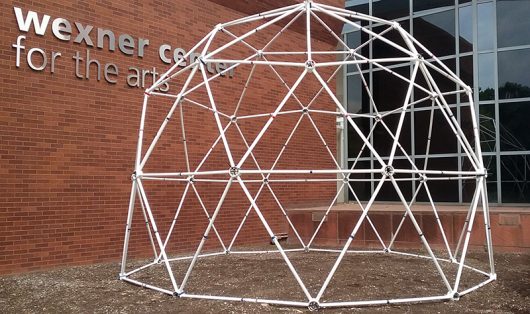
The geodesic dome constructed by OSU students sits outside of the Wexner Center for the Arts. Credit: Kathleen Senge | Lantern Reporter
Black Mountain College is permanently closed, but Ohio State students can now explore the school’s legacy through a new exhibit at The Wexner Center for the Arts.
“Leap Before You Look: Black Mountain College 1933-1957,” opens Friday.
Black Mountain College was an experimental liberal arts school in North Carolina that was focused on the arts and encouraged teachers and students to collaborate, improvise, and create beyond traditional disciplines. It remains a model for contemporary art institutions today, including the Wex, according to its website.
The exhibit contains over 100 works of art in multiple mediums, all created by students and teachers from the school. Works include a collage painting by Robert Rauschenberg, loom-woven room dividers by Anni Albers and a woven wire sculpture by Ruth Asawa. In addition, performances created and inspired by choreographer Merce Cunningham and composer John Cage are set to be performed on Friday following a curators’ talk.
Helen Molesworth, chief curator at The Museum of Contemporary Art in Los Angeles, and Ruth Erickson, assistant curator at The Institute of Contemporary Art in Boston, began working on the exhibition four years ago. The Wex is the final stop for the exhibition which has already been on display in Boston and Los Angeles.
“What made Black Mountain unique was the proposition of (the school) having been formed around art,” Erickson said.
Several Ohio State professors based their curriculum for this semester on the exhibition, including Erica Levin, who teaches a graduate seminar in Art History.
“I hope that students will see the exhibition as a leaping off point, no pun intended, for thinking about art’s place in larger debates around education and its role in a democratic society,” Levin said.
Levin’s students will study the work in the exhibit itself but also the history and legacy of Black Mountain College and its impact on art education.
“The class begins by looking at the debates that took place among the faculty at Black Mountain College about how to best foster student development in the context of an experimental college which deemphasized grades, and placed experience at the center of its curriculum,” Levin said.
One of the ideas Black Mountain College was known for was embracing failure as a way to learn and improve oneself.
“It’s a really bold statement to make in a culture that is scared of failure,” Erickson said.
Erickson said Buckminster Fuller failed on his first attempt to develop the geodesic dome, a geometric dome-like structure while teaching at Black Mountain College. In honor of Fuller’s invention, Ohio State students constructed a geodesic dome outside of the Wex.
“The school was founded on the principles of learning through experience, so we are trying to think about creative ways to engage that as a principle in our own research over the course of the semester,” Levin said.
Levin said she thinks the exhibit can reach even those students who are not involved in the arts.
“This is a unique exhibition that does more than focus on works by famous artists, it interrogates the art as a social and experiential process during a vital moment in 20th century history. I hope it will inspire creative experimentation in and beyond the classroom,” Levin said.
The exhibition is set to remain on display through Jan. 1. A curators’ talk is set to begin at 5 p.m. on Friday with performances to begin at 6:30, 7, and 7:30 p.m. Admission to all events is free for students with a Buck-ID.


